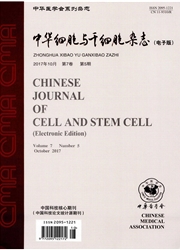

 中文摘要:
中文摘要:
目的回顾并分析国内有关干细胞移植临床研究方面的文献质量。方法检索2002年至2011年收录于CNKI文献数据库中有关干细胞的临床研究文献,参考2010年版报告随机临床试验的CONSORT声明中对照检查清单上的条目,对检索结果进行分析。结果检索到符合要求的文献55篇,文献质量呈逐年上升趋势;治疗病症由最初的血液病向心脏病等其它疾病延伸,其中治疗心脏病的文献占23.6﹪,研究设计方面,平行试验占49.1﹪,随机试验占21.8﹪,对病人入选标准进行说明的占49.1﹪,有预先设计结局指标的占60﹪,研究病例在30例以上的占50.9﹪,所有研究均没有样本量的预先设定。结论我国干细胞临床研究科研设计及论文撰写质量有待进一步提高,尤其是样本量的预先设定。对纳入及排除标准和干预措施的说明应详细,以做到可重复性,对结果的分析应包括利与弊两方面。
 英文摘要:
英文摘要:
Objective To review and analyze the quality of the clinical trial reports on stem cell transplantation in china. Methods All primary reports of clinical trials with stem cells indexed in CNKI database from 2002-2011 were included. The reporting characteristics and methodological details of trials were examine and the quality of reporting was assessed according to the Consolidated Standards of Reporting Trials (CONSORT) Statement in 2010. Results A total of 55 articles which met the inclusion criteria were analyzed. The reports' quality increased year by year. In addition to hematopoietic diseases, many other diseases were treated with stem cells. For example heart disease accounted for 23.6 %. Parallel trials accounted for 49.1% ;randomized trials 21.8 %. No report undertook sample size calculation. The criteria for patient enrollment were described in 49.1% reports; preplanned endpoints were included in 60 % reports. More than 30 participants were recruited in 50.9 % trials. Conclusions The quality of the clinical trial design and report needs to be further improved, especially sample size calculation. Inclusion and exclusion criteria and intervention measures should be described in detail so that other investigator can repeat the trials. New findings and limitations of the trials should be emphasized in the discussion.
 同期刊论文项目
同期刊论文项目
 同项目期刊论文
同项目期刊论文
 Water extract of Hedyotis Diffusa Willd suppresses proliferation of human HepG2 cells and potentiate
Water extract of Hedyotis Diffusa Willd suppresses proliferation of human HepG2 cells and potentiate Jiedu Xiaozheng Yin, a Chinese herbal formula, inhibits tumor angiogenesis via downregulation of VEG
Jiedu Xiaozheng Yin, a Chinese herbal formula, inhibits tumor angiogenesis via downregulation of VEG Enhancement of Antitumor Activity of Low-Dose 5-Fluorouracil by Combination With Fuzheng-Yiliu Granu
Enhancement of Antitumor Activity of Low-Dose 5-Fluorouracil by Combination With Fuzheng-Yiliu Granu Application of serum pharmacology in evaluating the antitumor effect of Fuzheng Yiliu Decoction from
Application of serum pharmacology in evaluating the antitumor effect of Fuzheng Yiliu Decoction from 期刊信息
期刊信息
